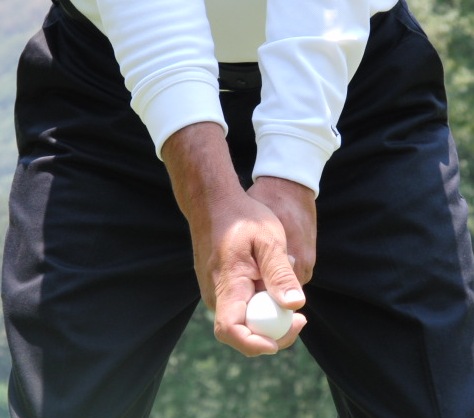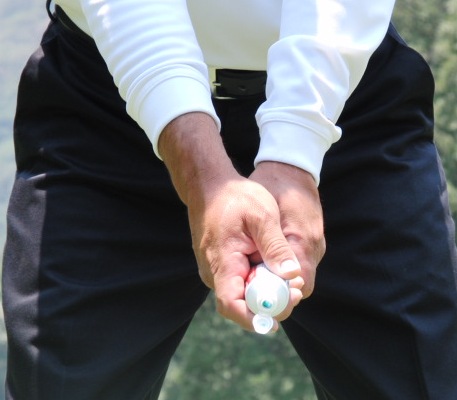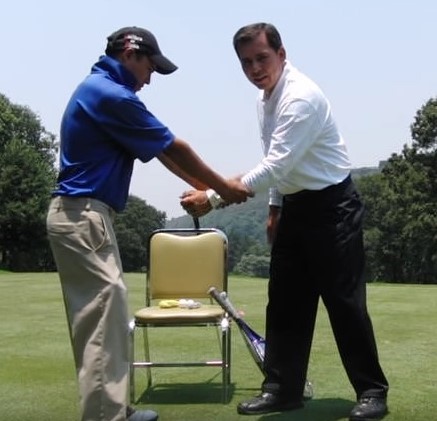
Talking in the 19th Hole
DRIVER. The extreme pressure of the hands-on grip is one of the main errors, even in players of an acceptable level. Excessive hand tension is a swing killer because tight muscles are slow muscles. The tension starts in the hands but moves to the arms, shoulders, and back, limiting body turn and whip through impact.
Excessive pressure is normal in beginning players because they are learning to master the hands’ position and the movements of the swing. Beginners tend to train without letting go of the grip because they do not want to lose the correct position. This habit causes a lot of stress on the hands, that the hands get tired and that blisters appear. The pros we must teach beginners that after a shot, they release the grip, relax their hands, and retake the grip following a routine.
We must teach the players to have and maintain adequate pressure to control the club from the short game. Over time they will take the soft grip and swing naturally.
A student, owner of the famous Cuadra boots, told me about the errors in the swing: «the goat always returns to the mountain.» This is a reality in terms of having a lot of pressure on the grip since it is a very recurrent error in which intermediate and advanced players tend to fall. The vicious circle occurs when the player misses some shots and instinctively takes the strongest grip, which causes him to continue missing. The player seeks to correct his swing by making other adjustments when the root of the problem is excessive pressure from the grip’s hands.
In clubs with medical care, members take their blood pressure frequently. Similarly, players can ask golf pros to check the pressure of their hands on the grip. This habit will significantly help your game.
The correct pressure of the hands-on the grip stimulates the use of the shoulders, facilitates the leverage and release of the wrists, and increases the clubhead’s speed.
The experienced pro knows that the ball’s sound on impact and the ball’s flight are a clear reference to the pressure of the hands-on the grip. Based on this, I have had the satisfaction of helping some players by sensitizing them to the grip’s correct pressure.
There are several ways to achieve the correct grip pressure; the most common are:
– The scale from 1 to 10. This form is subjective, but it is useful to achieve the correct pressure. It consists of taking the grip and immediately putting the club upright. In that position, take the grip as soft as possible; this point is 1. Then press as hard as possible; this point is 10. Then gradually increase and decrease the pressure, determining a pressure for each number. Most shots will be made at a pressure of 5 or less.
– A familiar image or feeling. Hold a bird, an egg, a banana, a toothpaste, a racket, a bat, give a greeting, or lead a child by the hand. The point is that the sensation or image is familiar to you and sensitizes you to the grip’s pressure.



– Take the pro’s arm. The pro asks the player to take his arm as if it were the grip. The pro helps you become aware of the proper pressure of your hands on the grip.

PUTTS. It has become fashionable to watch videos before competitions to motivate players. The classic script is exciting segments of commercial films, shorts of people who did extraordinary feats, forceful messages from men who do not give up, images and statements of successful athletes, scenes of previous triumphs, players celebrating and raising trophies, etc. All this with uplifting music that lifts the spirit.
The objective of these videos is to stimulate the players the desire to succeed. Like a talk by the pro or any other resource that seeks to influence the psychological state of the players, the video should not be an end in itself, but a means, a tool. It is the medium chosen to convey an idea, a message, and provoke a mental process that favors the best possible functioning and maximum performance.
What do players need right now? This is the crucial question, the starting point for determining the psychological strategy. Later, it will be necessary to decide how this strategy is applied but always based on that answer. And it can happen that players do not need, and even harm them, the message of that video that their pro likes so much.
In general, increasing motivation is more typical of periods not close to competencies, when interest has decreased. It is assumed that the pro must always motivate the players, and it is not like that. You will have to do it when necessary, that is, when those who are not sufficiently motivated need the pro’s action to cover that deficit.
However, before a competition, players are usually quite motivated and do not need to motivate themselves further. So, if you encourage them with these videos, you run the risk of causing an overactivation that can harm performance.
In addition to this risk, other factors show us why we must be cautious with the indiscriminate use of videos without knowing very well what effect they will have:
– Individual differences. A video’s impact can be similar for most people, but there are sometimes decisive differences. What motivates one stresses another. What encourages one annoys another. What gives one confidence creates insecurity for another.
– The type of task that the player must do. Extra motivation can be useful for sports where physical effort predominates or where a high dose of aggressiveness is essential. But in golf, where the predominant tasks are precision, being over activated affects the touch.
– The abuse of video. The abuse in the video’s use causes that its impact is less and that the players are fed up with them.
This does not mean that the videos should not be used. The point is to use them correctly so that they are effective, for this we must consider:
– The psychological needs of the players.
– The content is following the psychological needs of the players.
– That its effect is favorable.
– Anticipate the impact that the video will have on the players.
– Have the advice of a sports psychologist. FORE.
